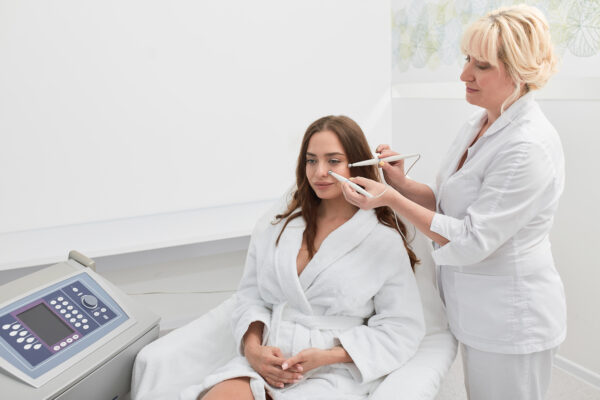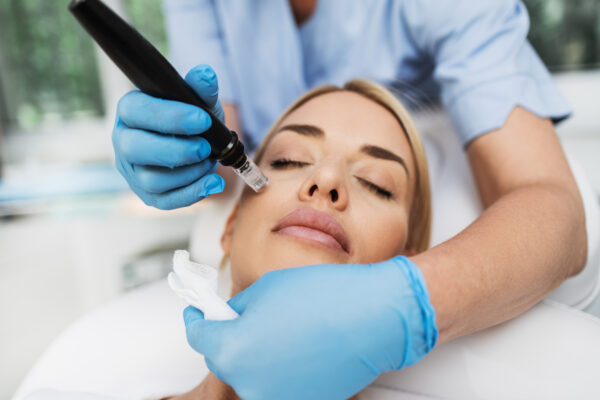The Dark Side of the UK Cosmetics Training Industry: Injectable Fillers, Deceptive Advertising, and Threats to Business


The aesthetic industry is plagued by widespread poor training that puts patients at risk and leaves students thousands of pounds poorer. As you are browsing Facebook, the post immediately stands out.
A two-day training program that costs £1,500 and teaches students with backgrounds in medicine and beauty therapy how to administer dermal fillers is being advertised.
This advertisement for a course in invasive cosmetic procedures is just one of thousands that can be found on social media platforms.
Even though there are plenty of good options, some vendors are peddling instruction that is way below industry standards.
There has been an “enormous” increase in the number of institutions offering instruction over the past two years, according to specialists.
This industry is a part of the wider non-invasive cosmetics market, which the government estimates will be worth £3.6bn by the end of the year.
However, there is a lack of regulation in this area. Getting started on a course requires no prior knowledge or preparation.
Many higher education institutions will accept freshmen into introductory courses in exchange for payment.
These programs guaranteed to turn students who had never administered a dermal filler or anti-wrinkle injection into skilled practitioners in less than a week.
Students find it challenging to distinguish between good and bad courses as a result of the industry’s expansion.
In addition, experts in the field have noted a pervasive “culture of silence” wherein students feel they cannot report negative experiences or seek recompense from businesses for fear of legal repercussions, online harassment, or even physical threats.
Misled by deceptive online advertisements
Our research into one hundred different service providers’ Facebook pages suggests there are many more new academies than previously thought.
To further complicate matters, there is such a plethora of courses available that many students rely solely on online reviews to make their course selections.
The market is flooded with legitimate organizations offering comprehensive training.
However, proponents cautioned that the prevalence of deceptive advertising practices on the internet makes it difficult for prospective students to determine whether or not the course they are enrolling in will actually provide them with a worthwhile education.
Some have suggested that social media is a “catalyst” for the issue at hand.
Many people get suckered in by Instagram ads and Facebook pages of training providers when they’re looking to break into the industry because of how well they market themselves.
They use fancy-sounding names like “academy” and “university” and offer “advanced certificates” and “diplomas” to make themselves seem more credible.
On closer inspection, however, it becomes clear that they are not qualified to teach in any capacity.
They’ve only recently begun administering these treatments themselves, and the certificates are meaningless given that they’re learning by observation.
In a recent report, the Advertising Standards Authority stated that they had issued five formal warnings to training companies for using misleading advertising.
Marketers frequently use catchy slogans like “Be your own boss” and “Girl Boss” to pique consumers’ interest.
Some of these advertisements encourage customers to “change your life today!” while others promise them the chance to “make a six-figure salary.”
It’s not uncommon for businesses to advertise “limited time only” sales that slash incredibly steep amounts from the cost of courses, sometimes by the thousands of pounds.
It’s all part of a pervasive advertising culture that can be overwhelming for students trying to pick the right major.
Do we have a shot at getting some sort of regulation in place?
Last year, the All-Party Parliamentary Group on Aesthetics, Wellbeing, and Beauty opened a probe into the norms surrounding the provision and promotion of non-invasive aesthetic procedures.
As part of this process, norms for training are being evaluated.
The group’s co-chair, Member of Parliament (MP) Carolyn Harris, said they have yet to find an ideal collection of training materials.
The group believes Minister for Mental Health, Suicide Prevention, and Patient Safety Nadine Dorries will use the inquiry’s findings as a springboard for new legislation based on the recommendations made by the panel.
However, this problem of inadequate training will not go away unless the government takes action.
Although there are obstacles to providing the quality of care your patients deserve, reputable Botox training programs are confident in their ability to help you overcome them. To improve the quality of their lives immediately, invest in your own education and professional growth.
Training Courses for Medical Spas


Common procedures performed in medspas include Botox, dermal fillers, dermaplaning, microneedling, microdermabrasion, and even skin tightening.
Medical spa services have risen in popularity over the past few years, and careers in this field bridge the gap between the cosmetic and medical sectors.
If you’re curious about both fields and have the drive to get certified, working in a medical spa could be a great fit for you.
A Medical Spa: What Is It?
A medical spa, also known as a medspa, offers cosmetic medical procedures that are less invasive than those at a standard spa. These procedures require medical training or a comparable level of education and certification.
Botox, dermal filler, dermaplaning, microneedling, microdermabrasion, and even skin tightening are typical medspa treatments. Facials, massages, and reflexology are just some of the ways that a medspa goes above and beyond the typical medical spa.
Could I get training for a medspa?
Medical spa services are considered primarily cosmetic in some jurisdictions while primarily medical in others. Depending on how your state regulates medspa services, you may need to complete primarily medical or beauty courses on your way to becoming a medspa practitioner.
In states like Georgia and California, for instance, only medical professionals like doctors and NPs are allowed to administer such treatments. However, advanced or medical estheticians are permitted to perform in Nevada and Minnesota.
1. Training for careers in Botox
Botox is a top cosmetic medspa treatment. It’s non-invasive, effective, safe, and long-lasting. Botulinum toxin A smooths lines and wrinkles when injected under the skin.
Who Can Inject Botox?
The legality of Botox injectors varies from state to state. In every jurisdiction, the service may be provided by medical doctors, including surgeons. Botox services may also be offered by the following professionals:
-
Dentists/dental surgeons
-
Eye doctors or surgeons
-
Licensed vocational/practical nurses
-
MAs
-
NPs
-
PAs
-
RNs
Botox training duration
One to two weeks is the typical length of time spent in Botox training.
Cost of Botox training
Botox training costs may differ from one provider to the next. To illustrate, a single Botox training session with one provider can cost around $1,700 on average.
2. Training for Professions in Dermal Fillers
Wrinkles and other facial flaws can be remedied without the need for surgery thanks to dermal fillers. Dermal fillers are non-toxic injections used to restore volume to the skin.
Who is allowed to inject dermal fillers?
In some states, dermal fillers can be administered by medical professionals or those with equivalent training and qualifications.
Dermal fillers training duration
Training in dermal fillers may take up to two weeks.
Cost of dermal fillers training
The expense of receiving training in dermal fillers can vary depending on the provider. The cost of training, for instance, might start at $1,275 and go up to $2,070.
3. Training for a career in Microdermabrasion

The technique of microdermabrasion involves using a specialized instrument with an abrasive surface to exfoliate the skin.
The skin is thoroughly cleansed and exfoliated with microdermabrasion. Hyperpigmentation, acne, and wrinkles are just some of the skin problems it’s supposed to fix.
Microdermabrasion is a method of exfoliating the skin using a specialized tool with an abrasive surface. To get what they want, some people turn to chemical aid. However, estheticians are rarely allowed to use chemicals when performing it.
Who can do microdermabrasion on your face?
Many doctors and nurses are trained to perform microdermabrasion. Furthermore, estheticians and master estheticians are permitted to provide the service to varying degrees in some states.
Microdermabrasion training duration
Courses in microdermabrasion typically take 600 hours, on top of any prior aesthetic education. In some states, only medical professionals are legally allowed to enroll in such programs.
Microdermabrasion Training Cost
Courses in microdermabrasion range in price. However, for around $500, you can finish an online training course.
4. Training for Jobs in Dermaplaning
In order to remove dead skin cells and fine hair, a surgical procedure called dermaplaning is performed. It evens out skin tone and reduces fine lines for a more radiant appearance after use. Dermaplaning is a skin exfoliation method similar to microdermabrasion. Dermaplaning, on the other hand, calls for a dermatome or scalpel and not a spinning brush.
Who can do dermaplaning?
Dermaplaning is a surgical procedure that should only be done by a qualified medical professional.
Dermaplaning training duration
One to three days is all it takes to complete a dermaplaning course.
Dermaplaning Training Cost
Certification to perform dermaplaning can cost anywhere from $250 to $400 or more.
5. Training for a career in Microneedling

Microneedling is a skin-tightening and anti-aging procedure that uses several, extremely tiny needle punctures.
Microneedling is a skin tightening and anti-aging treatment that employs the use of multiple, very small needle punctures in a sterile environment. As the skin heals, it produces more elastin and collagen. It causes minimal discomfort and has a negligible recovery period.
Who can inject microneedling?
Microneedling is typically done by a dermatologist, plastic surgeon, cosmetic nurse, or surgeon. However, depending on the law in your state, a licensed esthetician might be able to.
Microneedling training duration
Microneedling certification can be earned in as little as a day or two, and many cosmetic laser training programs include it as part of their curriculum. It’s estimated that 1,200 hours of study are needed to become a master esthetician.
Microneedling training cost
The price of a microneedling training course could be $200-$500 or more.
Who can legally administer Botox and other Medspa treatments in your state?
States sometimes restrict who can administer Botox and other treatments. Each state can also break down laws by the board, and many states change laws frequently. This makes it difficult to determine who can perform Botox and other procedures in your area.
To get accurate and up-to-date information, contact your state’s medical board. Medical boards’ contact information can be found at https://dentox.com/medical-dental-and-nursing-state-boards/.
Dentox can provide you with the training you need to better serve your patients and expand your practice. For online Botox training and live training with patients, visit https://dentox.com/all-courses/botox-training/ and https://dentox.com/live-courses/.
To extend his career, New England bowler Josh Tongue opted to get Botox injections


Botox could relieve the pressure on the nerves in Tongue’s shoulder, making it possible for him to charge in with the ball again.
A small amount of Botox was ultimately all that was needed. And with that, Josh Tongue’s 15 months of suffering, lack of sleep, and inability to even make himself a cup of tea were over.
Two previous shoulder surgeries had been unsuccessful, and now a rib removal procedure was imminent.
Specialist after specialist had been consulted before this one was found. He was the one who speculated that a cosmetic injection could ease the pressure on the nerves in Tongue’s shoulder, allowing him to once again charge in with the ball in his hand.
At this very moment, on the eve of England’s Test summer, Tongue is awaiting his 711th cap.
From the moment he picked up an early morning call from an unfamiliar New Zealand number, Tongue’s week has been nonstop action. Tongue’s agent, Phil Weston, claims that just hearing Brendon McCullum’s voice “took his breath away” when he received the call. His shock was palpable. This, however, was not a dream.
McCullum included Tongue in the starting XI for Thursday’s one-off Test against Ireland at Lord’s because he thought he was ready after just two training sessions.
Overcoming adversity: Tongue’s story
Things could have turned out very differently. Over the course of the last 18 months, Tongue has contemplated quitting the sport on more than one occasion. Tongue sat on the sidelines for 434 consecutive nights, from June 2021 to August 2022. Getting through the day had become difficult, especially during the colder months. The freezing temperatures made the constant tingling and numbness in his arm worse.
In fact, discussions were held with the Professional Cricketers’ Association, whose backing is crucial.
But then the pressure began to ease. Tongue had decided to continue the battle regardless. He “wanted to find out how far he could go,” as Weston put it. However, before he had surgery, a third shoulder specialist named David Murray offered the unorthodox solution of Botox injections. Tongue followed suit, and in less than two months, he was back at the lanes.
It was in a 50-over match against Essex that he made his comeback. Tongue only needed eight overs to pick up two wickets and forty-one runs. He only played for Worcestershire five times that year (2022), but he was on the Lions’ squad that played against Sri Lanka A in the winter, and he took eight wickets.
Alan Richardson, the head coach for Worcestershire, says that seeing his player’s shoulders drop and chest expand afterward “worked wonders for him.” What he went through was something I hope no one else has to experience. He had to delve below the surface. His enthusiasm for the sport is the driving force. He’s a real inspiration for the guys.”
To prevent future problems, Tongue has gotten another round of Botox injections. It’s enough to get him through the summer, and maybe even to start a regular schedule after that.

Tongue has had more Botox injections to prevent future issues.
‘There was a lot to work with’
“He was one of those guys who were sure to achieve well in life,” said Gavin Haynes, father of Worcestershire middle-order batsman Jack Haynes and, more crucially, head of the county’s Developing Player Program during Tongue’s pre-Academy days.
Tongue relies heavily on pace. In the case of the Ashes series, those extra clicks are well worth it. Brydon Carse and Jamie Overton, for example, might have been in the running to play against Australia if they hadn’t been injured. Tongue has surpassed Sam Cook and Craig Overton, two of the best seamers in the County Championship, and this is likely due to his improved pace.
In fact, a metatarsal injury in 2018 prompted Tongue to reevaluate: “He used to hit the ball with his toes but has now flattened out a bit. That’s forced him to work technically rather hard, and it’s resulted in some slightly new shapes. He puts in a lot of time aligning his body, and it has paid off in the form of increased speed.”
But being fast isn’t enough to get you an England debut or 162 first-class wickets at a little bit over 26 per game.
Even when “not feeling great” or “not in such a terrific spot,” technically, “he has an unfailing ability to be very accurate,” says Richardson. “Like Ben Stokes, he bowls from little outside the line of scrimmage, giving the impression to the batter that the ball is on the way in. But when Josh is on, it stands up, swings away, and attacks from both sides. He can be quite a handful when he does that effectively.”
“He’s capable of moving up a notch”
When Tongue was 24, he was nearly forced to retire from cricket; when he’s 25, he’ll be playing on the international stage.
“Josh’s cricket has a lot of room to grow,” Weston remarked. He’s just starting to get back into bowling after a long layoff, and I think he’s capable of much more than he’s showing right now.
Despite his initial reluctance, Tongue has finally decided to stay at Lord’s, where both of his parents will be present.
“Phil was scheduled to be working with me on Thursday,” says Haynes of Tongue’s senior class. “The problem is that he’s had to call it quits due to a personal emergency. I had to bring in backup coaches. Knowing him, I figured he’d be like “I can’t let Gav down,” so I gave him a quick call to tell him, “You’re going to Lord’s!”
In fact, prior to Monday, Tongue Junior had never even visited the Home of Cricket. Now that he is a Test cricket player, he must learn to deal with its infamous slope.
Courses on Botox administration are now offered for medical professionals. Courses can be taken online at https://dentox.com/all-courses/ or in person at https://dentox.com/live-courses/ with actual patients. Find out how to enhance the lives of others by improving their physical appearance, health, and vision.
Who Is Authorized to Administer Botox?


The regulations concerning the injection of Botox vary widely from one jurisdiction to the next.
The proliferation of non-invasive cosmetic procedures like Botox injections has led to an increase in inquiries into the training and experience required of those who perform such procedures. In this article, we’ll examine the background checks and training that medical professionals must have before they can offer Botox to their patients, as well as other important information they need to know.
Who is permitted to administer Botox?
In a nutshell, it’s conditional. There is considerable variation in the legal requirements for administering Botox from one jurisdiction to another. In most of the country, physicians can give Botox to their assistants, advanced practice registered nurses (APRNs), or even nurses. Although delegation laws vary by state and have subtleties in each, there are two general frameworks. The first is the dictator model, and the second is the deference model.
In accordance with the dictator model, the state will specify who can administer medical treatments (including Botox). In the state of California, for instance, licensed nurses, physician assistants, and advanced practice registered nurses (APRNs) can administer Botox to patients. The dictator model is straightforward as well as rigid. In a state based on the dictator model, there is no compliance value in delegating treatment to an individual who lacks specific authority.
The burden of deciding who may administer medical treatments is placed on the delegating physician in states that employ the deference model. When selecting who should receive a treatment like Botox, doctors are bound to a high degree of care and risk losing their license if they make the wrong call. The doctor might choose to have the procedure performed by anyone they believe is competent and safe to do so. You may distribute authority, but that doesn’t mean you should.
Effectively treating more people and improving their health can be accomplished through the delegation of certain medical procedures. Nonetheless, the doctor may face legal and ethical complications as a result. The doctor could be held responsible for the patient’s injury, for instance, if the delegated procedure is botched. In addition, the doctor could be held responsible for subpar oversight of the procedure’s execution. If this happens, the doctor may have to explain why they chose to delegate the procedure and show that they provided adequate support.
What is doctor supervision?
When a doctor is in charge of a team of healthcare workers, including nurses, medical assistants, and other support staff, they are called the supervisor. For the sake of patient safety and care providers staying within their areas of expertise, physician supervision is an integral part of the health care delivery system. It lessens the potential for harm in the event of an unfavorable reaction to the treatment or an unforeseen complication, such as facial paralysis, a botched injection, or extensive bleeding.
The level and type of doctor supervision may differ depending on the type of healthcare facility, the services being offered, and the legislation of the issuing state. Medical oversight typically falls into one of the following categories:
- Direct supervision: During the performance of certain procedures or remedies, the doctor is physically present and personally overseeing.
- Indirect supervision: The physician is available as required for consultation and direction, but is not physically available during procedures and treatments.
- General supervision: The physician provides general direction and supervision but is neither physically present nor available for consultation during the procedure or treatment.
So what if they’ve completed a course to become a Botox injector?

Botox injector training is intended to give students the skills they’ll need to administer Botox safely and effectively.
You can get certified to administer Botox by taking a course designed specifically for that purpose. The goal of Botox injector training is to equip students with the knowledge and expertise to do Botox injections for cosmetic purposes in a safe and effective manner. Facial anatomy, patient selection and consultation, injection techniques, safety and risk management, and aftercare are just some of the subjects that may be covered in a normal Botox injector course. Under the close supervision of professionals, course participants can get both classroom instruction and practical experience injecting Botox into mannequins. Course completion will increase your knowledge and skills, but it will not qualify you to practice the method legally.
Even if you have completed an injector training course and are a Licensed Vocational Nurse (“LVN”) in California, you are not permitted to inject in that state due to the dictator model. A medical or nursing board license is still required, even if you have a certificate proving you have the necessary skills. In California, however, a nurse who has taken a course to become an injector of Botox can legally take on this responsibility on behalf of a doctor. Now that the nurse has the knowledge and experience to administer Botox, the doctor may assign this task to her if she has proven herself to be capable.
The laws and regulations controlling who can administer Botox vary greatly by state and jurisdiction, despite the fact that Botox injections are usually deemed safe and effective when delivered by a skilled and experienced healthcare provider. If you want up-to-date information, it’s best to get in touch with the medical board in your state. Visit https://dentox.com/medical-dental-and-nursing-state-boards/ to get in touch with the appropriate medical board in your state.
With the help of Dentox, medical professionals may perfect their Botox injection techniques. You can enroll in a seminar in any one of our many convenient U.S. locations or study with us in real-time via the Internet or on demand. Visit https://dentox.com/live-courses/ and https://dentox.com/all-courses/botox-training/ for more information about our live and online courses, respectively.
In light of the side-by-side photo of ‘Notorious,’ fans have begun to speculate that Conor McGregor has undergone Botox treatment


Conor McGregor’s fans have wondered if the fighter has ever used Botox.
Conor McGregor, a superstar of the Ultimate Fighting Championship, is currently in Las Vegas filming for the upcoming season of The Ultimate Fighter in anticipation of his comeback fight against Michael Chandler this year.
Fans of UFC superstar Conor McGregor have joked about whether or not he has undergone plastic surgery to achieve his new appearance.
After suffering a defeat at the hands of Dustin Poirier in 2021 and breaking his leg in the process, the UFC superstar has been sidelined for close to two years. However, the Irishman has ramped up his comeback since it was announced that he would be fighting Michael Chandler again as part of the latest season of The Ultimate Fighter.
McGregor was in Las Vegas over the weekend filming the coaching segment of the series, in which the two fighters will face off against one another in a head-to-head bout. He also watched Jon Jones, a UFC heavyweight, make a successful return to the sport by defeating Cyril Gane by choking out the latter to win the championship.
McGregor has been seen sporting a new look in the weeks leading up to his return, and the UFC has now released a video of him and Chandler making their predictions for the main event of UFC 285.
And the comment section was ablaze with excitement from the fans. They believe McGregor’s appearance (especially his face) has been artificially enhanced.
Some of Conor McGregor’s supporters have speculated that the fighter may have used Botox. And just recently, Henry Cejudo hinted that “Notorious” might actually be doping with performance-enhancing drugs.
While fans eagerly await Conor McGregor’s return to UFC action, the fighter is busy flaunting his lavish lifestyle and travels on social media. Like clockwork, any “Notorious” post or statement generates discussion, but after a fan juxtaposed a recent photo of McGregor with one from a few years ago, some began to wonder if he had undergone botox treatment.
Most commenters attribute McGregor’s striking physical transformation to the use of performance-enhancing drugs like steroids or growth hormones, though some point to Botox as the culprit.
Due to McGregor’s undeniable muscle growth, his detractors have repeatedly claimed that he uses performance-enhancing drugs. Henry Cejudo, a former UFC lightweight and featherweight champion, is the most recent MMA celebrity to question McGregor’s sudden bulk.
There’s something quite odd about McGregor’s appearance, according to Cejudo. He’s concerned that his profile gives the impression that he’s overly hefty. His subsequent remarks are as follows: “I’m wondering what exactly he’s taking and if it’s good for him. This is due to the fact that increasing one’s size and strength is achievable, but not without costs.”
Dentox makes it easier for medical and beauty professionals to learn how to give safe and effective Botox injections. You can sign up for a seminar at one of the many places around the country where they are held, or you can sign up for one of our live, online, or on-demand courses. To learn more about our live and online courses, please visit https://dentox.com/live-courses and https://dentox.com/all-courses/botox-training.
After a dose of Botox, this stunning woman’s eyebrows look like the Nike swoosh

The 22-year-old Tik Tok got Botox to prevent wrinkles, but the treatment had the unintended consequence of making her eyebrows resemble the Nike ‘Swoosh.
Because the shape of her eyebrows after Botox treatment resembled the ‘Nike’ logo, an American woman became a media sensation.
As a result of receiving Botox, a 22-year-old American woman known as “Queen Blackwell,” who is an influencer on the short-form video platform TikTok, experienced unpleasant side effects.
Her brows, as seen in the video she posted, resembled the inverted Swoosh logo of the popular sportswear company Nike.
She said, “After getting Botox in my forehead, I saw that the contour of my eyebrows had changed to resemble the Nike Swoosh.”
Carolyn Davidson, a graduate student specializing in graphic design at Portland State University in the United States, designed the now-iconic Nike logo in 1971. It combines a dynamic sense that seems to burst out at any moment with a gentle, streamlined pattern.
Blackwell’s “Nike eyebrows” aren’t noticeable unless she concentrates, at which point they take on the shape of the Nike logo.
She went so far as to scream and laugh at her eyebrows while she was in the restroom.
Several online users commented that “Her eyebrows appear like square roots (√)” or “Could someone tell me this is a prank?” while others noted that “Botox has to be dissolved” or that “Her eyebrows look like a dancer.”
She has over 1.5 million followers on TikTok, making her an influential user of the platform.

Botox has grown in popularity among American adults in their twenties and thirties as a means of delaying the onset of skin aging.
When it comes to preventing the signs of aging from showing on the skin, Botox has become increasingly popular in the United States among people in their twenties and thirties. Previously, this treatment was reserved for those in their middle years.
27% of Americans who received Botox in 2012 were under the age of 35, according to a survey that the Wall Street Journal (WSJ) cited on January 15th. In comparison to 2015’s 21%, this is a significant increase of 6%.
Dentox is a training program for medical and aesthetic specialists that teaches them how to inject Botox in a way that is both safe and effective while minimizing the amount of product that is wasted. If you want to improve your practice for your patients and grow your business, Dentox can help you achieve both goals.
Injectable education is a topic on which Dr. Howard Katz is widely regarded as a preeminent authority. He offers both traditional classroom instruction and online, on-demand access to his course materials. Botox training is offered both online (at https://dentox.com/all-courses/botox-training/) and in person (at https://dentox.com/live-courses/) with real patients.
Botox for Cosmetic Purposes: Tips for a Younger Appearance


Botulinum toxin is a neurotoxin used to temporarily paralyze muscles after being injected into the affected area.
This cosmetic treatment has swept the beauty industry because it is a safe, effective way to get younger-looking skin without surgery. To fully understand the benefits and drawbacks of Botox before jumping on the bandwagon, one must first learn what areas can be treated. When you search for a trustworthy clinic to administer your next round of Botox, we’ll cover all the bases in this piece.
How do you define Botox?
The active ingredient, botulinum toxin, is a neurotoxin that can be injected into muscles to temporarily paralyze them.
Wrinkles and fine lines on the face are one of the most common aesthetic concerns treated with Botox. It prevents wrinkles from forming or deepening by stopping the nerve signals that normally cause facial muscles to contract.
Botox is used for more than just cosmetic purposes; it is also effective in treating medical conditions like chronic migraines, muscle spasms, and hyperhidrosis (excessive sweating).
Botox may seem like a magic bullet for getting younger-looking skin, but it comes with a host of potential complications. These can range from temporary bruising at injection sites to permanent drooping of the eyelids in extreme cases.
What is the mechanism of action of Botox?
Botox is a neurotoxin, so it blocks nerve impulses that would normally travel to and from the muscles. When injected into targeted areas, it weakens or temporarily paralyzes the facial muscles that create wrinkles.
Injections are quick and easy procedures that can be done in a pinch. Using extremely thin needles, Botox solution is injected into problem areas. No recovery time is necessary, and the procedure can be finished in under 15 minutes.
Two days after treatment, most patients will notice an improvement, with the full effect showing up between one and two weeks later. The average length of time between Botox treatments is three to six months.
You can only get rid of dynamic wrinkles (like frown lines) with Botox, which is caused by contracting muscles. Sun damage and a general lack of elasticity in the skin are not addressed.
Botox injections carry the same risks as any other medical procedure. Occasionally, you may experience flu-like symptoms, bruising at the injection site, or droopy eyelids.
What parts of the body can get Botox?

If you have seen a horizontal frown line across your forehead, Botox injections are a fantastic option.
The use of Botox for its anti-wrinkle and anti-aging effects is growing in popularity. It is typically applied to the areas of the face that show the first signs of aging (wrinkles, fine lines, and sagging skin). The most common Botox injection sites are listed below.
Forehead Lines: Botox injections are a good solution for those horizontal lines that have appeared across your forehead. Botox, by relaxing the underlying muscles, can eliminate the creases and stop them from further deepening as time passes.
Crow’s Feet: Those fine lines and wrinkles at the outer corners of your eyes can be a dead giveaway of your age or a sign that you’ve been under a lot of stress recently. As a result of Botox’s muscle-relaxing effects, wrinkles around the injected area appear less pronounced.
Frown Lines (Glabellar Lines): These furrows between the brows can give the impression of anger or sadness even when you don’t feel that way. Botox reduces the appearance of frown lines by paralyzing the underlying muscles in this area.
Lip Lines: Botox is effective in treating smoker’s lines and “barcode lines” above the upper lips because it relaxes the muscles in that area, reducing the amount of creasing that occurs when pursing.
What is the price of Botox?
When deciding whether or not to get Botox, cost is naturally a major consideration. Botox costs can differ depending on where you live, the level of experience and skill of your provider, and the number of units you require.
Usually, you can expect to pay between $10 and $15 for one unit of Botox. However, as opposed to charging per unit used, the majority of providers bill by area treated. For instance, 10–20 units may be needed to treat forehead lines, whereas 5–15 units may be needed to treat each side of crow’s feet.
The number of target locations is also a factor in the final price. One area, such as the forehead or crow’s feet, may cost $150–$300 to treat, while treating multiple areas may cost $1,000 or more.
How do you locate a trustworthy Botox provider?
It’s in your best interest to do some research into your options before settling on a service. Verify that they have the appropriate licensing or certification. The injector’s track record with Botox is also something to think about.
Referrals from friends and family can also be useful. If you or someone you know has had good luck with Botox, you can ask them to recommend a reliable medical professional.
Botox can make wrinkles less noticeable and give the appearance of a more youthful appearance when administered correctly. Only after carefully weighing the potential advantages and disadvantages should treatment be initiated. It is recommended that you seek out a qualified medical professional who has experience injecting Botox into the desired areas.
When deciding whether or not to get Botox for cosmetic reasons, it’s important to give serious thought to all of the pros and cons. Individuals can make an educated decision about whether or not to undergo a cosmetic procedure like Botox injections by learning about the procedure’s efficacy, the areas it can treat, the risks involved, and the providers they can trust.
Dentox teaches professionals in the fields of medicine and cosmetics how to deliver Botox in an efficient and secure manner. You have the option of enrolling in a class at any of our many accessible sites across the United States, or you can study with us online in real-time or at your own speed. You may find information regarding our live courses at https://dentox.com/live-courses/, and information regarding our virtual courses can be found at https://dentox.com/all-courses/botox-training.
Injecting Botox: Can LPNs Do It?


LPNs provide assistance with a variety of patient care activities, such as assessments, medication administration, vital sign monitoring, and basic patient care.
Do you want to know if LPNs can administer Botox? Find out what LPNs can do and what they’re responsible for when it comes to administering Botox. Let’s investigate the exciting connection between health and beauty!
Practice Areas for LPNs
LPNs are involved in a wide variety of patient care activities, such as assisting with assessments, medication administration, vital sign monitoring, and basic patient care. Hospitals, nursing homes, clinics, and even in-home care are just some of the places they put their skills to use. LPNs play a crucial role in patient care, often serving as the first point of contact for those in need of medical attention.
However, it is essential that LPNs understand and adhere to the standards of their profession. While the specific laws and regulations that govern licensed practical nursing (LPN) vary from one jurisdiction to the next, all LPNs are required to report to and work under the direct supervision of an RN or other appropriately licensed healthcare professional. Patients benefit from comprehensive and coordinated care thanks to this team-based approach. The state’s laws and regulations governing nurses set limits on a licensed practical nurse’s (LPN) scope of practice.
LPNs’ scope of practice includes the administration of medication. It’s true that LPNs can give patients medication, but the drugs they can give and how they can give it might be restricted. It is common practice for registered nurses to handle the administration of intravenous (IV) medications, while licensed practical nurses (LPNs) may be responsible for the administration of oral and some injection medications. LPNs must have a complete understanding of medication safety protocols and should always look for further explanation or assistance if they feel they need it.
Educating and advocating for patients is another important duty of LPNs. Patients and their loved ones benefit greatly from the education they receive regarding their medical conditions, treatments, and self-care. By liaising between patients and other medical staff, LPNs can make sure patients’ needs and concerns are heard and met. Better health outcomes and patient satisfaction are the results of tailoring care to each person.
State-Specific Regulations
It is important for people in the United States to understand that licensed practical nurses (LPNs) have different duties and restrictions depending on the state in which they work. Thanks to the state-level regulatory frameworks in place, licensed practical nurses (LPNs) provide safe and effective healthcare.
The scope of practice for licensed practical nurses (LPNs) can vary depending on a number of factors, such as the tasks and procedures they are permitted to perform, the extent to which they need to be supervised, and whether or not they need to obtain additional certifications or specialized training.
Regulators from the state government are heavily involved in regulating and supervising LPN practice. These groups, which can include state boards of nursing, are responsible for establishing and enforcing guidelines for LPN practice. They are in charge of the granting and renewal of LPN licenses, the establishment of educational prerequisites, and the handling of complaints regarding breaches of professional conduct.
It is imperative that LPNs investigate and comprehend state-specific regulations, especially when it comes to administering treatments like Botox. Different states have different requirements for licensed practical nurses (LPNs), including the types of treatments they can administer, the minimum amount of supervision needed, and any necessary certifications or training. To ensure legal and ethical practice, LPNs should study the rules and guidelines established by their state carefully.
Contacting your state’s medical board is your best bet for getting up-to-the-minute details. Visit https://dentox.com/medical-dental-and-nursing-state-boards/ to find the appropriate medical board in your state and their contact information.
LPNs and the Botox Industry: A Role Analysis

A patient’s care and outcomes will improve when a licensed practical nurse (LPN) is involved in Botox treatments.
Having a licensed practical nurse (LPN) involved in Botox treatments is beneficial for both the patient’s care and the patient’s outcomes.
Possible Roles of LPNs in Botox Treatment:
- Patient Assessment: LPNs can assist with Botox treatment patient assessment. Interviews, medical history, and procedure suitability evaluations may be done. This evaluation aids in determining whether or not the patient is a good candidate for Botox and ensures that expectations are realistic.
- Preparing the Treatment Area: LPNs may prepare the Botox treatment area. Aseptic technique, sterilizing the injection site, and organizing supplies and equipment are required. LPNs improve treatment safety and efficiency by keeping the environment clean.
- Assisting with the Procedure: LPNs can assist MDs and NPs with Botox injections. They may use instruments or support the patient’s skin. Their presence ensures a smooth and well-coordinated procedure, improving patient satisfaction.
- Patient Education and Follow-Up: LPNs educate patients before and after Botox. They can answer questions about the procedure, side effects, and aftercare. Licensed practical nurses aid patients in arranging follow-up appointments, tracking their progress, and voicing any concerns they may have.
LPN Duties and Responsibilities During Botox Procedures:
- Assessing patients at the outset and making notes about what was found.
- Making sure everything is clean and in order in the treatment room.
- Providing necessary assistance to medical personnel during the procedure.
- Keeping a close eye on the patient throughout the treatment and afterward in case of any complications.
- Instructing patients on the procedure, possible outcomes, and aftercare guidelines.
- Noting dosage, injection sites, and other pertinent treatment notes.
- Working in tandem with other medical experts to guarantee the best possible care for patients.
Specialized Training and Certification
The ability of licensed practical nurses (LPNs) to administer Botox can be improved through participation in specialized training and certification programs. As a whole, LPNs are in a prime position to perform Botox treatments due to their specialized training and certification. Dentox can provide you with the training you need to boost both the standard of care you provide to patients and the financial health of your practice. Botox training is offered both online (at https://dentox.com/all-courses/botox-training/) and in person (at https://dentox.com/live-courses/) with real patients.
A study from the University of Queensland: Botox could be a lifesaver


Prof. Meunier explained that Botox was initially created to treat strabismus in the eyes, but it now treats migraines, chronic pain, and spasticity.
What the public knows about Botox comes from photos of the emotionless faces of the rich and famous; nevertheless, a new study from the University of Queensland suggests that Botox may actually save a life.
The mechanism through which Botox, a medication derived from lethal biological material, reaches brain cells has been discovered by researchers at the University of Queensland.
The molecular mechanism through which Botulinum neurotoxin type-A, more commonly known as Botox, enters neurons has been discovered by researchers Professor Frederic Meunier and Dr. Merja Joensuu of the University of Queensland.
For example, Professor Meunier stated, “By applying super-resolution microscopy, we were able to demonstrate that a receptor called synaptotagmin 1 binds to two other well-characterized clostridial neurotoxin receptors to form a minute complex that sits on the plasma membrane of neurons.”
“Synaptic vesicles, which contain neurotransmitters necessary for proper neuronal communication, are invaded by the toxin after it has successfully hijacked this complex.”
“Botox interferes with the communication between nerves and muscle cells, resulting in paralysis.”
A successful botulism treatment
As a result of this discovery, new pharmaceutical targets for the treatment of botulism can be sought. Botulism is a rare but potentially fatal bacterial infection.
“By blocking connections between any two of the three receptors, we may prevent the deadly poisons from entering neurons and thereby reverse our discovery that this complex allows for toxin internalization.” Prof. Meunier remarked.
Botox was first created as a treatment for strabismus in the eyes, but it has now been discovered to be effective against migraines, chronic pain, and spasticity disorders as well.
It is now well-known as a wrinkle-smoothing cosmetic treatment and is commonly used in plastic operations. In addition, it is regularly utilized in plastic surgeries.
The muscle-relaxing effects of the neurotoxin
Dr. Joensuu said that in the past, it had been challenging to identify the specific mechanism by which the toxin worked to relax the muscles.
Dr. Joensuu claims that clostridial neurotoxins are among the most powerful protein toxins associated with humans.
“At this point, we have a comprehensive understanding of the mechanisms by which these toxins are taken up by neurons and cause intoxication at amounts that are important from a therapeutic standpoint.”
Dentox helps medical and cosmetic practitioners learn how to administer Botox effectively and safely. You can enroll in a seminar at any one of our many convenient U.S. locations, or study with us online in real-time or at your own pace. Our live courses can be found at https://dentox.com/live-courses/ and our virtual courses can be found at https://dentox.com/all-courses/botox-training.
Kim Kardashian reveals in a new video that she had Botox injections in a very specific spot on her body

Kim Kardashian, queen of reality television, said in a sneak peek at the upcoming season of The Kardashians that she received the non-surgical Botox surgery while undergoing vocal training.

In the most recent episode of “Keeping Up with the Kardashians,” Kim Kardashian revealed that she has undergone cosmetic procedures.
Kim Kardashian admitted that she has had cosmetic procedures in the most recent episode of Keeping Up with the Kardashians.
During an episode of the popular reality TV show, the reality star discussed the peculiar place where she gets her Botox injections.
On Tuesday, the 42-year-old actress shared a scene from the most recent season through Snapchat (May 23). In the film, she alluded to the upcoming conflict between the famous sisters.
Towards the end of the video, there is a brief scene in which Kim engages in conversation with a voice coach as the sisters embark on a new endeavor.
This is what the voiceover said: “We are currently working on the recording of an album. It is a requirement of ours to participate in singing classes.”
After that, the video showed Kim as she was taking a lesson, and her voice coach explained: “The muscles in my neck are getting a workout.”
Then Kim responded by stating, “The other half of mine have presumably been treated with Botox, so I can’t, like…”
After admitting she wants to take her time finding a new partner so she doesn’t repeat the “same mistakes” she’s made in the past, the star’s comments come as no surprise.
Kim has been dating nobody since she and Pete Davidson broke up in August of 2022, but she says she’ll always be a “hopeless romantic.”
On the latest episode of the On Purpose With Jay Shetty podcast, the developer of SKIMS mentioned that, as a mother of four, she has to consider “several aspects” before getting involved with someone new.
“I think there are so many factors, especially when you have kids and are conscious of individuals that enter your life, so I’m going to take my time,” Kim said when questioned about her plan to take things slowly.
She continued, “I just believe it needs to be different for me if I can look at everything I did incorrectly and try not to repeat the same mistakes while taking my time.”
“I think that I will always be a hopeless romantic, someone, who longs for love and who finds great joy in sharing and building a life with another person.”
The actress, who has been married three times previously, claims she is not currently seeking love and has kept herself busy to avoid feeling lonely.
Improve the quality of your patient’s lives by mastering new skills that will help them look and feel better. If you have the proper education, your patients will profit from your expertise. Visit https://dentox.com/live-courses/ and https://dentox.com/botox-training/ to find out about online and in-person patient training events, respectively.





